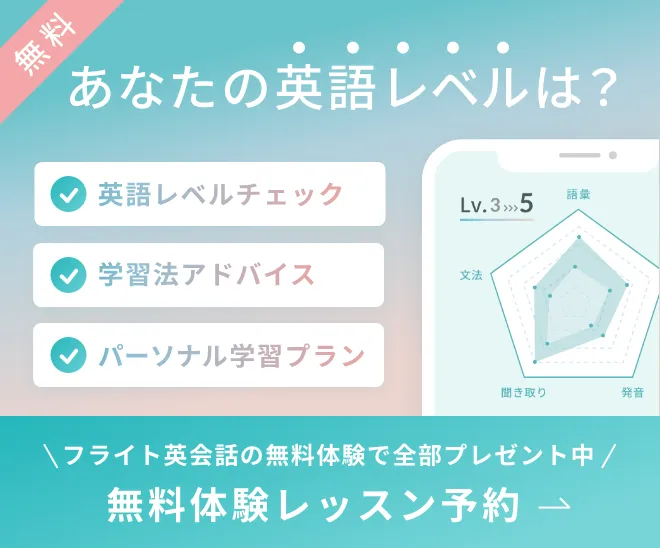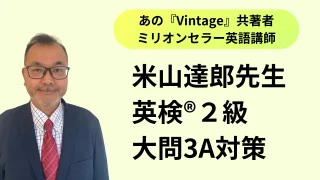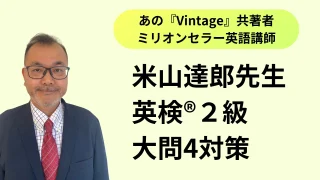本ページはPRが含まれています。
みなさんこんにちは、米山達郎(よねやま・たつろう)です。

米山 達郎よねやま たつろう
京都大学の文学部を卒業してから、長い間、河合塾で模擬試験を作るリーダーをしていました。現在は、資格試験や大学入試の問題を作ったり、学校の先生たちのサポートをしたりしています。これまでに作った本には、『英文法・語法 Vintage』(いいずな書店)、『英作文バイブル和文英訳編/自由英作文編』(Z会)、『パラグラフリィーディングのストラテジー1/2/3』(河合出版)などがあります(いずれも共著です)。
📘 詳しいプロフィール・著書情報はこちら → 米山達郎先生プロフィール
私はふだん、大学入試や英検®、TOEICなどのテストを作る仕事をしています。このブログでは、英検®2級の問題を見ながら、「英検®2級ではこういう問題が出ている」「こんなスキルが必要とされる」ということを、わかりやすく伝えていきます。
ちょうど文化人類学者がある村に行って、その村の暮らしを観察して「この村にはこんな文化がありますよ」と紹介するように、私は英検®2級という「世界」をみなさんに紹介する気持ちで書いています。
このブログを読むことで、「英検®2級ってこんな感じなんだ」「こうやって勉強したらいいんだな」と実感してもらえたらうれしいです。
なお、ブログに出てくる問題はすべてオリジナルで、実際の過去問ではありません。英検®の過去問を見たい方は、こちらをご覧ください:
■英語学習にお悩みの方へ!ぜひプロにご相談ください!
>PHLIGHT英会話の無料体験:英会話相談・レベルチェックレッスンができるのはこちら
目次
英文読解問題(大問3B (27)〜(31))
1) どんな問題が出ているの?
大問3Bの(27)〜(31)は4つのパラグラフから構成された英文を読んで、その内容について設問に答える問題です。
本文の分量はだいたい350 words程度です。
2) どうやって解けばいいの?
まず、基本的な「本文の読み方」と「設問の解き方」を確認しておきます。
【ステップ1】本文の内容を大まかにとらえる
各パラグラフが何について書かれているか整理しながら速読して、最終的には「英文全体のテーマ、筆者の主張、パラグラフどうしの論理展開」をざっくりとつかむことが目的です。
ただし、各パラグラフからそれぞれ順番に設問を作っているので、「¶1を読んで問1を解く→¶2を読んで問2を解く→¶3を読んで問3を解く→¶4を読んで問4を解く…」というやり方で解く方が実戦的と言えます。
(注)問5だけはWhat is the main message of the passage?という「筆者の言いたいこと」や「英文全体をまとめた内容」に関わりますが、問1〜4までが「ヒント」のような役割をしているので、わざわざ英文全体をもう一度読まなくても十分に解くことが可能です。
↓
【ステップ2】設問を読んで、答えのヒントを探す
次に、設問を読んで、設問のキーワード(語句や日付、人名など)も手がかりにして、「この設問の答はパラグラフのどのあたりにあったかな?」と関係ありそうな部分に戻って、その部分だけはもう一度きちんと精読して内容をきちんと理解します。
↓
【ステップ3】本文と選択肢をくらべる
本文と選択肢で表現が異なっていても、内容がほぼ同じなら「正解」になります。このような、本文と選択肢の「言いかえ(パラフレーズ)」には十分に気をつけましょう。
3) 実際にやってみよう!
それでは、オリジナル問題にチャレンジしましょう。
制限時間5分で解いてみてください。
次の英文の内容に関して,(27)から(31)までの質問に対する答えとして最も適切なもの,または文を完成させるのに最も適切なものを1,2,3,4の中から一つ選び,その番号のマーク欄をぬりつぶしなさい。
Music and Memory
Music is something people experience in many different ways. For some, it is just entertainment, while for others, it plays a bigger role. Scientists have found that music can help people remember things because it creates a strong link between sound and memory. In some studies, students who listened to certain songs while studying could recall more information when they heard the same songs again during a test. This method is now sometimes used by teachers who want to make learning easier or more fun for their students. In addition, background music may help students stay focused and study for longer periods.
Because of this connection between music and memory, it is now being used to support people with memory problems. In care homes for older adults, songs from their youth are often played. When they hear these songs, many of them begin to talk about memories from decades ago. Even those who have trouble speaking can sometimes sing along, which shows how deeply music connects to memory. Staff members have noticed that these moments often bring smiles and improve the overall mood of the residents. This positive emotional response can help reduce feelings of confusion or loneliness.
This has inspired new kinds of therapy. In some hospitals, music therapists work with patients who are recovering from strokes or injuries. These therapists use instruments and singing to help patients rebuild lost skills. In one case, a man who could no longer speak well after a stroke improved by practicing the lyrics of his favorite songs. This example has shown therapists how powerful music can be as a recovery tool. Such therapies are now seen as helpful not only for physical recovery but also for emotional support. As a result, some hospitals have created music rooms for patients to enjoy and relax in.
Scientists are still learning how music affects the brain, but they agree that it activates many areas at once. Unlike reading or speaking, music uses sound, rhythm, and emotion together. This combination of sensory and emotional stimulation could be why it has such a strong effect on both memory and emotion. Some studies even suggest that musical training may improve attention and thinking skills over time. Experts believe that listening to music regularly might also reduce the risk of certain age-related brain conditions.
(27) In what ways do teachers use music to support learning?
1 They allow students to listen to any music they like during tests.
2 They play the same songs during both lessons and exams.
3 They encourage students to write songs about what they study.
4 They avoid using music so students can concentrate better.
(28) How does music influence older people in care homes?
1 It reminds them of events from their younger years.
2 It helps them to remember the names of other residents.
3 It encourages them to listen to new songs every day.
4 It improves their ability to solve puzzles and games.
(29) What is one way hospitals are using music to help patients?
1 They give music lessons to visitors in waiting rooms.
2 They use songs as a form of speech practice.
3 They teach patients how to read music to improve focus.
4 They ask patients to write music for other patients.
(30) Why do scientists believe music affects the brain strongly?
1 It involves different cognitive and emotional processes at the same time.
2 It requires people to study the meaning of each lyric.
3 It helps only when played at a certain volume.
4 It stimulates the same brain areas as speaking.
(31) What is the main message of the passage?
1 Music is mainly useful for entertainment and relaxation.
2 Using music regularly can help both the mind and memory.
3 Scientists now know exactly how music affects brain cells.
4 Older people benefit more from music than younger ones.
〈語句リスト〉
- entertainment 娯楽
- play a role 役割を果たす
- link つながり
- background music 背景音楽(BGM)
- stay focused 集中し続ける
- connection つながり、関連性
- memory problem 記憶障害、記憶に関する問題
- care home 高齢者施設(介護施設)
- sing along 一緒に歌う
- emotional response 感情的反応
- confusion 混乱
- loneliness 孤独
- therapy 治療、療法
- music therapist 音楽療法士
- stroke 脳卒中
- injury けが
- rebuild skills 能力を再び身につける
- lyrics 歌詞
- recovery 回復
- emotional support 心の支え、感情面の援助
- activate A Aを活性化する
- at once 同時に
- stimulation 刺激
- over time 時間とともに
- attention 注意力
- thinking skills 思考力
- reduce the risk 危険を減らす
- age-related 加齢に関連した
- brain condition 脳の状態
それでは解説です。
ここではパラグラフごとに設問の解説をしていくことにします。
¶1 ①Music is something people experience in many different ways. ②For some, it is just entertainment, while for others, it plays a bigger role. ③Scientists have found that music can help people remember things because it creates a strong link between sound and memory.
④In some studies, students who listened to certain songs while studying could recall more information when they heard the same songs again during a test. ⑤This method is now sometimes used by teachers who want to make learning easier or more fun for their students. ⑥In addition, background music may help students stay focused and study for longer periods.
(①音楽は、人々がさまざまな形で体験するものです。②ある人にとっては単なる娯楽かもしれませんが、別の人にとってはもっと重要な役割を果たします。③科学者たちは、音楽が記憶を助けることがあると発見しています。なぜなら、音と記憶の間に強い結びつきができるからです。④ある研究では、特定の曲を聴きながら勉強した学生が、その同じ曲をテスト中に再び聴いたとき、より多くの情報を思い出すことができました。⑤この方法は、学習をより簡単に、または楽しくしたいと考える教師たちによって使われることがあります。⑥さらに、音楽を流すことで学生の集中力が高まり、より長く勉強を続けられることもあります。)
(27) In what ways do teachers use music to support learning?
(どのような方法で、教師たちは音楽を使って学習を支援するのですか?)
☞④In some studies, students who listened to certain songs while studying could recall more information when they heard the same songs again during a test.(ある研究では、特定の曲を聴きながら勉強した学生が、その同じ曲をテスト中に再び聴いたとき、より多くの情報を思い出すことができました)より、2 They play the same songs during both lessons and exams.(授業とテストの両方で同じ曲を流す)が正解。授業とテストの両方で同じ曲を使うことで記憶が助けられ、これが「学習支援」として使われていることを読み取りましょう。
本文:while studying / again during a test→選択肢:during both lessons and examsと自然な言い換えになっています。
¶2 ①Because of this connection between music and memory, it is now being used to support people with memory problems. ②In care homes for older adults, songs from their youth are often played. ③When they hear these songs, many of them begin to talk about memories from decades ago. ④Even those who have trouble speaking can sometimes sing along, which shows how deeply music connects to memory. ⑤Staff members have noticed that these moments often bring smiles and improve the overall mood of the residents. ⑥This positive emotional response can help reduce feelings of confusion or loneliness.
(①このような音楽と記憶の関係から、現在では記憶に問題を抱える人々を支援するためにも音楽が使われるようになっています。②高齢者施設では、入居者が若い頃に聞いていた曲がよく流されます。③そういった曲を聞くと、多くの人が何十年も前の思い出を語り始めます。④話すのが難しい人であっても、一緒に歌うことができる場合があり、音楽と記憶が深く結びついていることがわかります。⑤施設のスタッフは、こうした時間が入居者に笑顔をもたらし、全体的な気分を改善することが多いと気づいています。⑥このような前向きな感情の反応は、混乱や孤独感を和らげる助けになるのです。)
(28) How does music influence older people in care homes?
(音楽は高齢者施設にいる人々にどのような影響を与えますか?)
☞③When they hear these songs, many of them begin to talk about memories from decades ago.(そういった曲を聞くと、多くの人が何十年も前の思い出を語り始めます)に注目。これはまさに「若い頃の出来事を思い出す」ことを示しています。よって1 It reminds them of events from their younger years.(若い頃の出来事を思い出させる)が正解。
本文:talk about memories from decades ago→選択肢:reminds them of events from their younger yearsと自然な言い換えになっています。
¶3 ①This has inspired new kinds of therapy. ②In some hospitals, music therapists work with patients who are recovering from strokes or injuries. ③These therapists use instruments and singing to help patients rebuild lost skills. ④In one case, a man who could no longer speak well after a stroke improved by practicing the lyrics of his favorite songs. ⑤This example has shown therapists how powerful music can be as a recovery tool. ⑥Such therapies are now seen as helpful not only for physical recovery but also for emotional support. ⑦As a result, some hospitals have created music rooms for patients to enjoy and relax in.
(①こうした発見は、新たなタイプの音楽療法を生み出しています。②いくつかの病院では、音楽療法士が脳卒中やけがから回復中の患者と一緒に取り組んでいます。③これらの療法士は、楽器や歌を使って、患者が失った能力を取り戻せるように支援しています。④ある事例では、脳卒中の後、うまく話せなくなった男性が、自分のお気に入りの曲の歌詞を練習することで改善しました。⑤この事例は、音楽が回復のための強力な手段になり得ることを療法士たちに示しました。⑥こうした音楽療法は今や、身体的な回復だけでなく、感情面の支えとしても役立つものと考えられています。⑦その結果、一部の病院では、患者が楽しんだりリラックスしたりできる「音楽ルーム」も設けられています。)
(29) What is one way hospitals are using music to help patients?
(病院が患者を助けるために音楽を使っている方法の1つは何ですか?)
☞④In one case, a man who could no longer speak well after a stroke improved by practicing the lyrics of his favorite songs.(ある事例では、脳卒中の後、うまく話せなくなった男性が、お気に入りの歌の歌詞を練習することで改善しました)に注目。これはまさに、「言語機能回復のリハビリとして歌を使っている」ことを意味しています。よって2 They use songs as a form of speech practice.(歌を話す練習の一種として使う)が正解。
(病院が患者を助けるために音楽を使っている方法の1つは何ですか?)☞④In one case, a man who could no longer speak well after a stroke improved by practicing the lyrics of his favorite songs.(ある事例では、脳卒中の後、うまく話せなくなった男性が、お気に入りの歌の歌詞を練習することで改善しました)に注目。これはまさに、「言語機能回復のリハビリとして歌を使っている」ことを意味しています。よって2 They use songs as a form of speech practice.(歌を話す練習の一種として使う)が正解。
(①科学者たちは、音楽が脳にどのように影響するかをまだ研究中ですが、音楽が脳のさまざまな領域を同時に活性化することには意見が一致しています。②読書や会話と異なり、音楽は音・リズム・感情を一緒に使います。③このように感覚と感情を同時に刺激することが、音楽が記憶や感情に強く作用する理由かもしれません。④いくつかの研究では、音楽の訓練が集中力や思考力を高める可能性があるとまで示唆されています。⑤専門家たちは、定期的に音楽を聴くことで、加齢に伴う脳の病気のリスクを減らす可能性があるとも考えています。)
(30) Why do scientists believe music affects the brain strongly?
(なぜ科学者たちは、音楽が脳に強い影響を与えると考えているのですか?)
☞③This combination of sensory and emotional stimulation could be why it has such a strong effect on both memory and emotion.(このように感覚と感情を同時に刺激することが、音楽が記憶や感情に強く作用する理由かもしれません)より、1 It involves different cognitive and emotional processes at the same time.(音楽は、異なる認知的・感情的な働きを同時に伴うから)が正解。
本文:sensory and emotional stimulation →選択肢:cognitive and emotional processesと自然な言い換えになっています。
(31) What is the main message of the passage?
(この文章の主なメッセージは何ですか?)
☞本文全体(¶1〜¶4)では、次のような点が語られています。
- 音楽が記憶の手助けになる(学生、テスト、学習)
- 高齢者の記憶を呼び起こす
- 病院でのリハビリに使われる
- 脳の広い領域を活性化し、感情や認知を支える
- 音楽が脳の健康維持にも役立つ可能性
つまり、音楽は「楽しみ」だけではなく、記憶や感情、脳の働きを支えるツールであるというのが本文の中心メッセージです。よって2 Using music regularly can help both the mind and memory.(音楽を定期的に使うことで、心と記憶の両方に良い影響がある)が正解。
まとめ:英文読解問題の学習対策
次の3点に気をつけて、過去問や類似問題を解いていきましょう。
1) 「パラグラフリーディング」を実行しよう
英文読解では、1つのパラグラフが1つの話題(トピック・情報)を伝えています。ですから、パラグラフ単位で「何について書かれているか=そのパラグラフの中心情報」を短く1文でまとめる練習をするのが効果的です。各パラグラフのまとめを繰り返して、最終的には「英文全体のテーマ、筆者の主張、パラグラフどうしの論理展開」が脳内に描けたら理想的です(このような英文読解の仕方を「パラグラフリーディング」と呼びます)。英検2級ではパラグラフごとに設問が解けましたが、今後はそのやり方が通用しない問題とも出会うことになるので、このような「パラグラフリーディング」を練習することを勧めます。
2)「キーワードに注目」して読むことを意識しよう
設問はよく、人名・場所・日付・数字・話題の単語などの「キーワード」を手がかりに答えることが多いです。ですから、キーワードを手がかりに「この設問の答えはどこに書いてある?」ということを探す練習をするのが効果的です。本文を読む際にも、設問で問われそうなキーワードである「人名・場所・日付・数字・話題の単語」に印をつけながら読むとさらに効果的です。本文と選択肢の表現がよく変形されるという話をしましたが、「人名・場所・日付・数字・話題の単語」などのキーワードはその変形がされにくい表現だといえます。つまり、選択肢と本文でも「人名・場所・日付・数字・話題の単語」などの表現はまったく(あるいは、ほぼ)同じなので、設問から本文の該当箇所へ戻るスピードが格段にアップすることになるのです。
3) 練習のときは「自分の言葉で説明する」力もつけよう
英文読解の練習では、問題を解いて終わりにせずに、各パラグラフや全体の内容を、自分の言葉で日本語にまとめてみるのがおすすめです。たとえば、「第1パラグラフは、このトピックの背景が書かれている」「第2パラグラフでは、筆者の主張の理由が説明されている」「全体として、○○が重要だという考えが伝えられている」…という感じです。こんなふうに、それぞれのパラグラフのポイントや、筆者が伝えたいことを整理することで、内容を正確につかむ力(読解力・要約力)がグッとアップします。

ポイントは、「何について・どう考えているのか(=テーマ+主張)」を、自分の言葉でまとめること。この練習をくり返すことで、英文を読んだときに論理の流れや重要な部分をすばやくキャッチできるスキルが身についてきますよ。
※英検®は、公益財団法人 日本英語検定協会の登録商標です。このコンテンツは、公益財団法人 日本英語検定協会の承認や推奨、その他の検討を受けたものではありません。
「最短」で英語を話せるようになるには?
英語を話せるようにはなりたい。でも、、、
- 何から始めたらいいのかわからない
- どの教材を使えばいいのかわからない
- まとまった時間が取れなくて勉強が進まない
- 英語力0なので自分にできるのか自信がない
このようなお悩みを抱える英語初心者の方は多いのではないでしょうか。
効率よく英語力を伸ばすには、セオリーがあります。今の英語力、目的、目標レベルを明確にして、継続的に取り組んでいくことが大切です。ぜひ、情報をしっかりとチェックして、あなた専用の学習プランを作成してください。
とはいえ、情報量も多く、どのように計画を立てればよいか悩まれる方も多いと思います。そんなときは、ぜひ「プロ」にご相談ください。PHLIGHT英会話では、無料体験レッスンで、英会話の学習相談や、英語レベルチェックを行っています。最短で英語を話せるようになるためのパーソナル学習プランもご提案しますので、ぜひお気軽にご相談ください。
■英語学習にお悩みの方へ!ぜひプロにご相談ください!
>PHLIGHT英会話の無料体験:英会話相談・レベルチェックレッスンができるのはこちら






